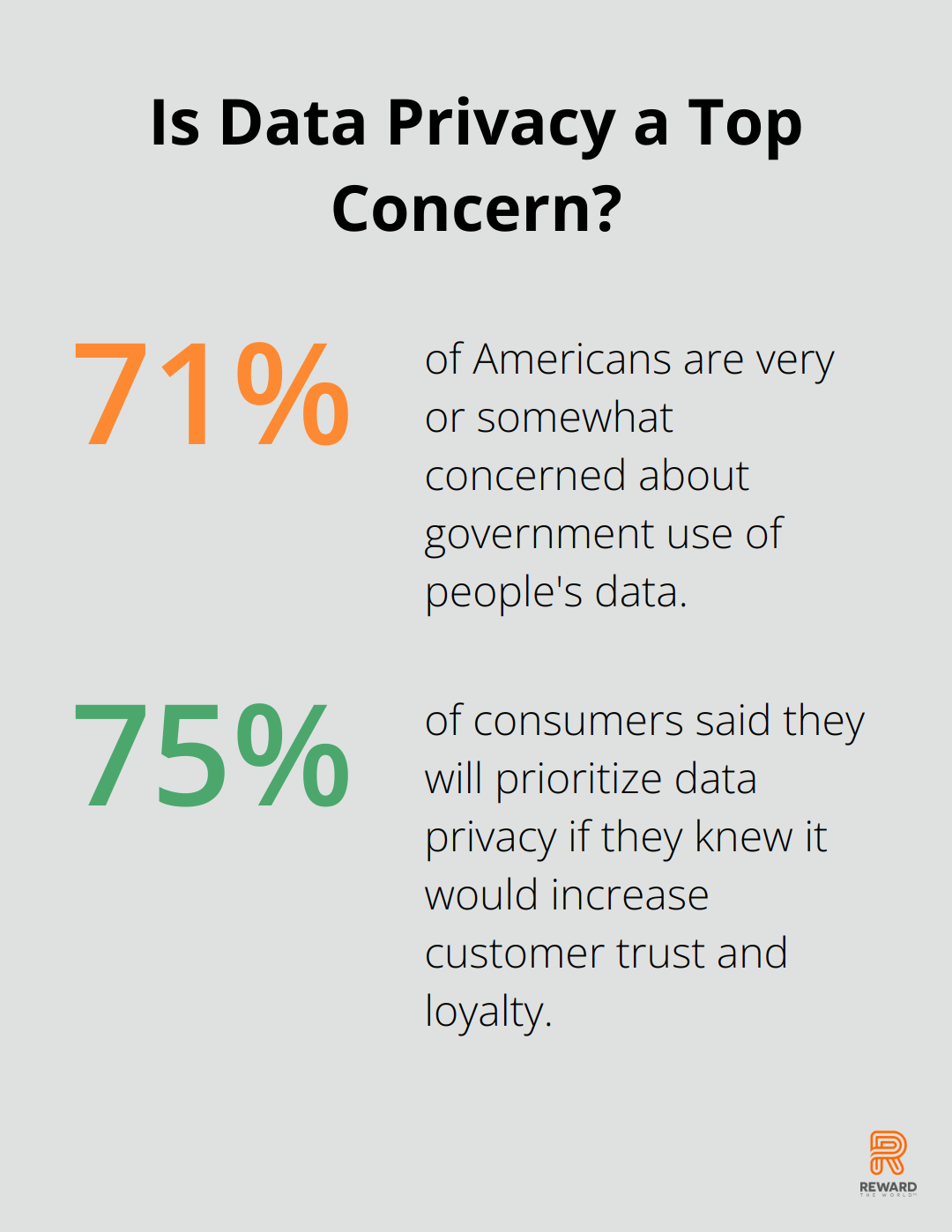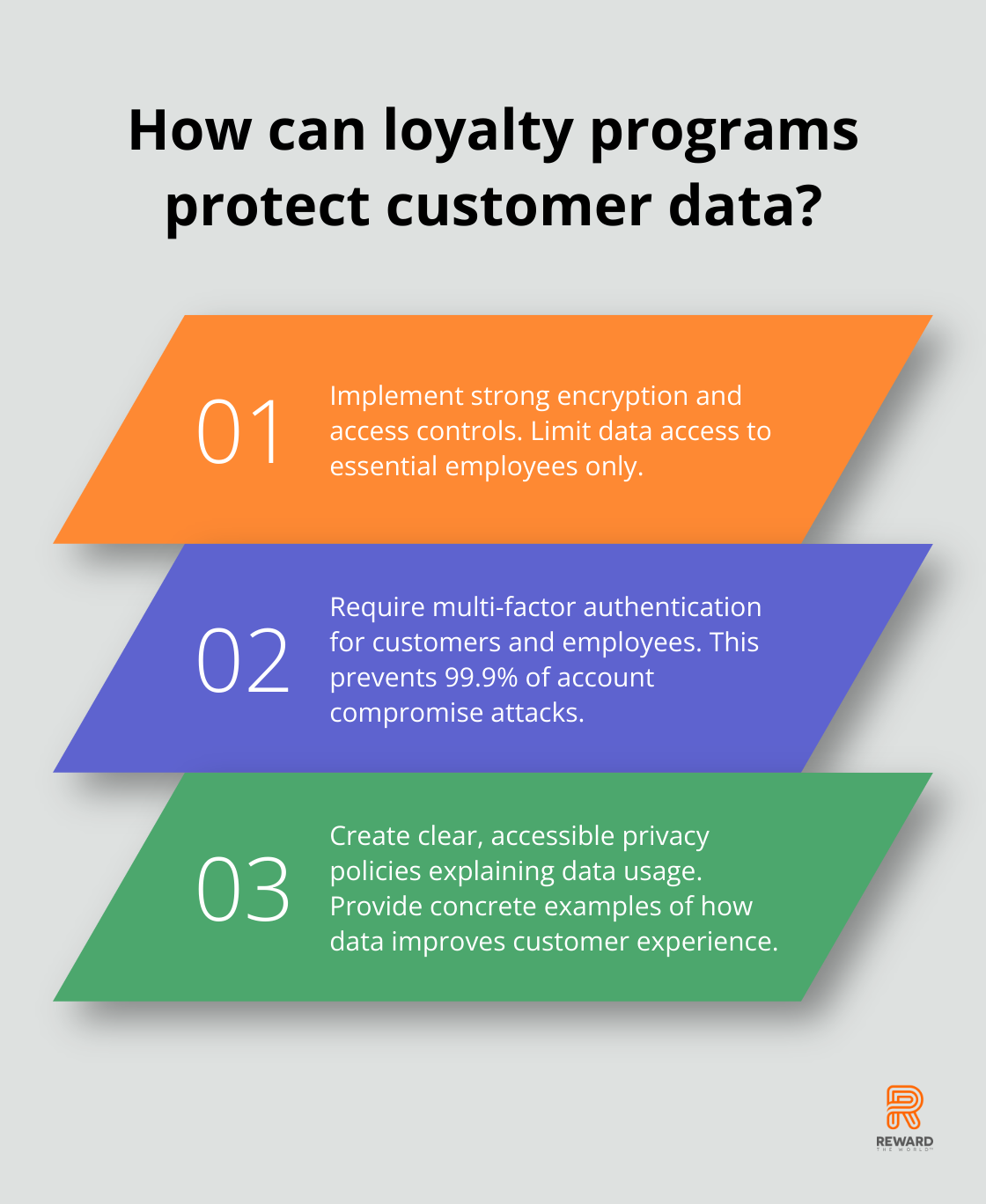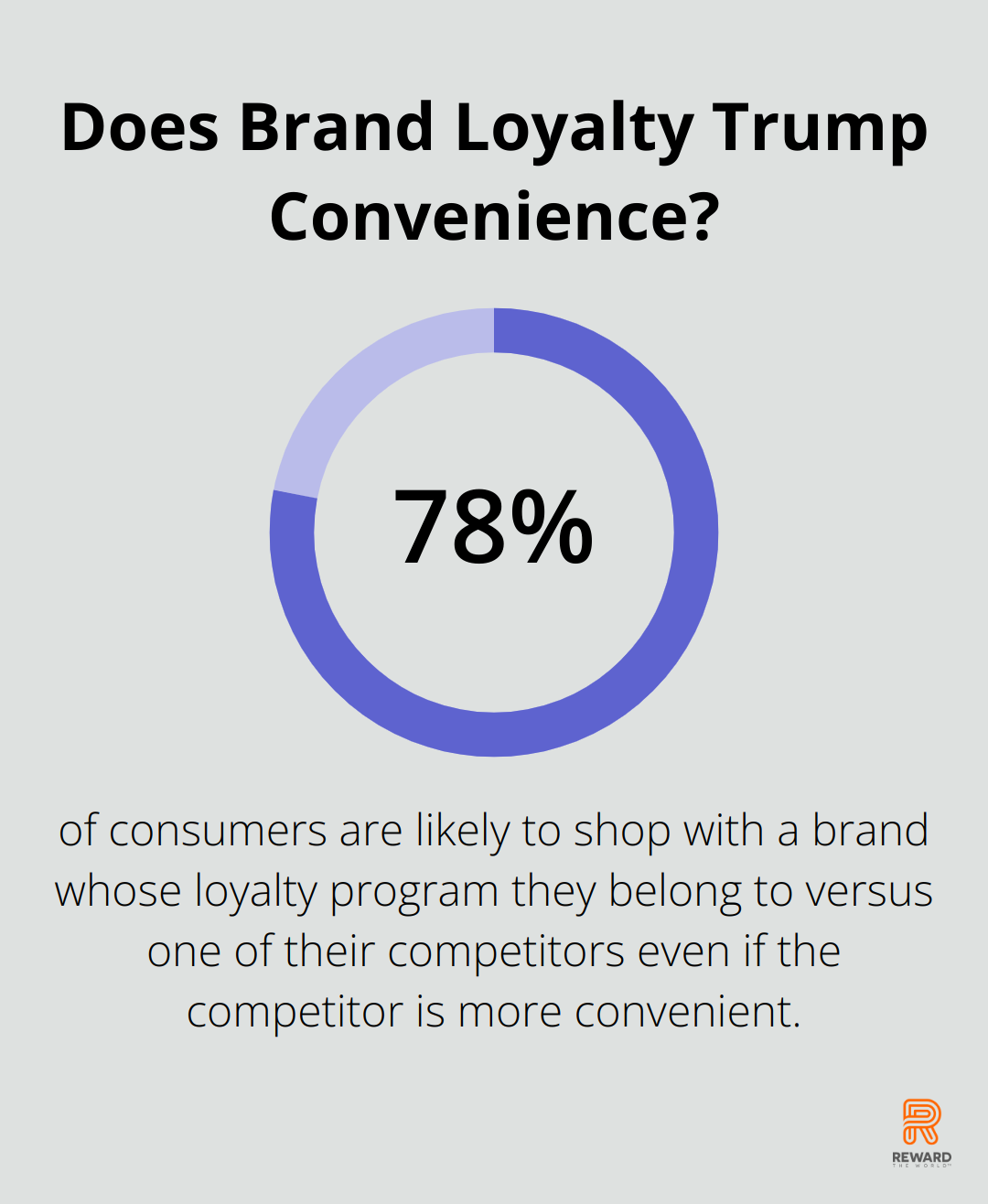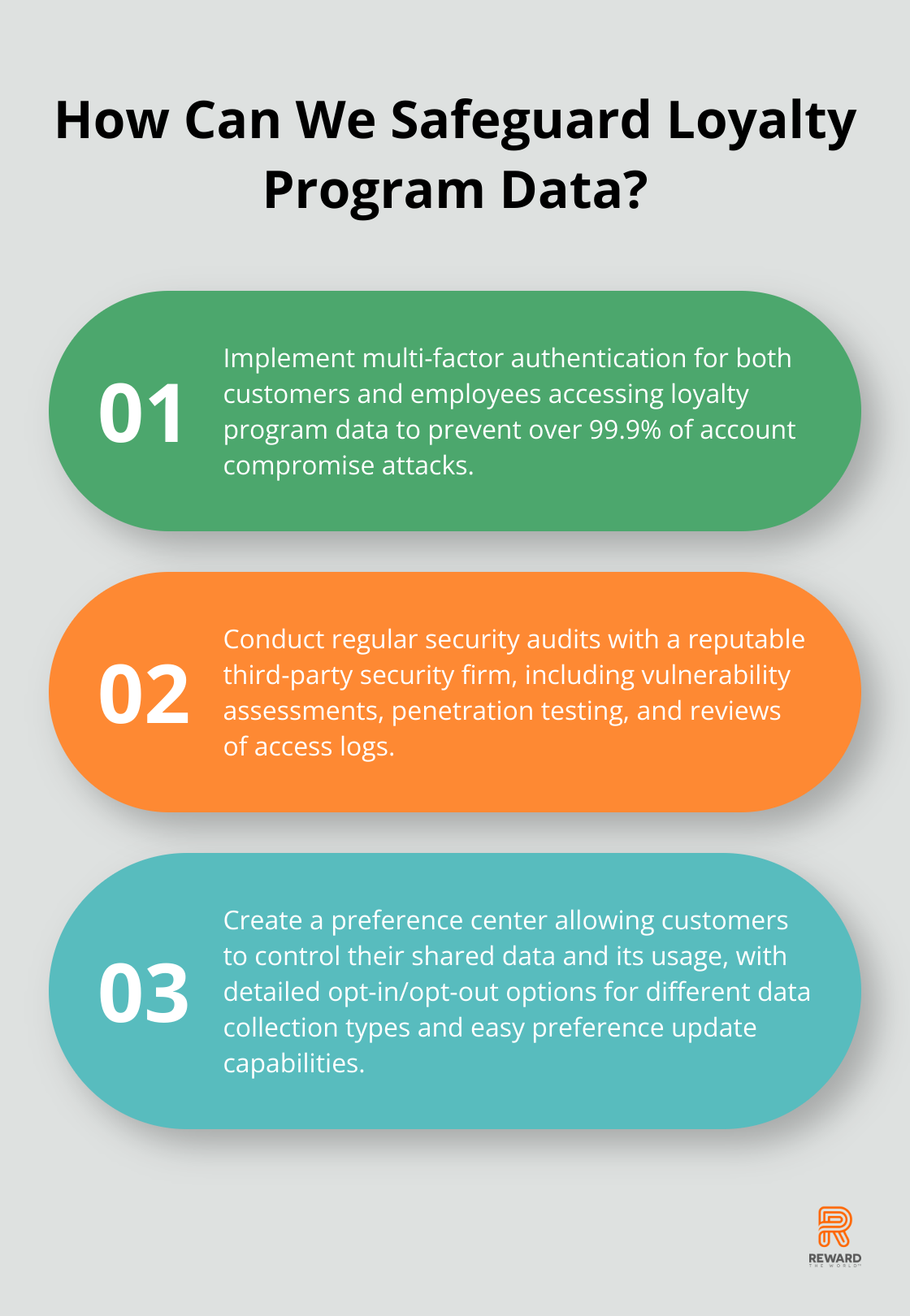
Data privacy has become a hot topic in the loyalty program landscape. With increasing consumer awareness and stricter regulations, businesses must prioritize protecting customer information.
At Reward the World, we understand the delicate balance between personalization and privacy in loyalty programs. This blog post explores best practices for safeguarding customer data while maintaining effective, engaging loyalty initiatives.
Why Data Privacy Matters in Loyalty Programs
Consumer Awareness Reaches New Heights
Data privacy has become a cornerstone of successful loyalty programs. A 2023 Pew Research Center report reveals that 71% of Americans are very or somewhat concerned about government use of people’s data. This heightened awareness compels loyalty program managers to prioritize transparency and security.

To address these concerns, we recommend implementing clear, jargon-free privacy policies. Explain in simple terms how you collect, use, and protect customer data. This approach not only builds trust but also helps you stand out in a competitive market.
Navigating the Complex Legal Landscape
The legal requirements for data protection continue to evolve. The General Data Protection Regulation (GDPR) in Europe and the California Consumer Privacy Act (CCPA) in the United States have set new standards for data privacy.
For loyalty programs, these regulations require explicit consent before collecting personal data. They also mandate giving customers the right to access, correct, and delete their information. Non-compliance can result in hefty fines (up to €20 million or 4% of global annual turnover under GDPR).
To stay compliant, we advise regular audits of your data collection practices. Ensure your loyalty program includes mechanisms for customers to easily manage their data preferences.
Trust: The Foundation of Customer Relationships
Brand trust plays a paramount role in loyalty programs. The 2025 Edelman Trust Barometer report highlights a profound shift to acceptance of aggressive action, with political polarization being a key factor.
When customers trust your brand with their data, they engage more deeply with your loyalty program. This trust translates into higher participation rates, more frequent purchases, and increased customer lifetime value.
To build and maintain this trust, proactive communication about data usage is essential. Update customers regularly on your privacy practices and any changes to your policies. Consider implementing a preference center where customers can easily control what data they share and how it’s used.
The Impact on Program Performance
Data privacy practices directly influence the performance of loyalty programs. A recent study found that 75% of consumers said they will prioritize data privacy if they knew it would increase customer trust and loyalty.
This trust correlates with increased program engagement. Customers who feel their data is respected and protected are more likely to:
- Provide accurate information
- Participate in surveys and feedback sessions
- Redeem rewards more frequently
These behaviors contribute to richer customer insights and more effective program optimization.
As we move into the next section on best practices for data protection, it’s clear that privacy isn’t just a legal requirement-it’s a strategic advantage. Companies that master the art of data privacy in their loyalty programs will find themselves well-positioned to build lasting, mutually beneficial relationships with their customers.
How Loyalty Programs Can Protect Customer Data
At Reward the World, we understand the importance of data protection in building trust and maintaining successful loyalty programs. Let’s explore some practical strategies to safeguard customer information effectively.
Implement Strong Encryption and Access Controls
Start by using strong encryption for all stored customer data. This includes industry-standard protocols for data at rest and in transit. Enforce strict access controls within your organization. Limit data access to only those employees who absolutely need it for their roles.
Require Multi-Factor Authentication
Implement multi-factor authentication (MFA) for both customers and employees accessing loyalty program data. This simple step can prevent more than 99.9% of account compromise attacks. Offer various MFA options, such as SMS codes, authenticator apps, or biometrics, to cater to different user preferences.
Create Clear and Accessible Privacy Policies
Transparency builds trust. Create a clear, jargon-free privacy policy that outlines exactly how you collect, use, and protect customer data. Make this policy easily accessible on your website and within your loyalty program interface.

Exceed legal requirements by providing concrete examples of how data improves the customer experience. For instance, explain how purchase history might offer personalized rewards or how demographic information helps tailor communications.
Conduct Regular Security Audits
Perform thorough security audits regularly. These audits should include vulnerability assessments, penetration testing, and reviews of access logs. Many companies overlook the importance of regular audits – don’t fall into this trap.
Partner with a reputable third-party security firm for these audits. Their external perspective can uncover vulnerabilities you might miss internally.
Train Employees on Data Privacy
Your employees form the first line of defense against data breaches. Implement a comprehensive data privacy training program for all staff members who handle customer information. This training should cover topics like identifying phishing attempts, proper data handling procedures, and the importance of maintaining customer trust.
Make this training an ongoing process, not just a one-time event. Regular refresher courses and updates on new threats can significantly reduce the risk of human error leading to data breaches.
These practices can significantly enhance data protection efforts in loyalty programs. In the next section, we’ll explore how to strike the right balance between personalization and privacy, ensuring your loyalty program delivers value while respecting customer data preferences.
How Loyalty Programs Balance Personalization and Privacy
Loyalty programs face a constant challenge: to provide personalized experiences while respecting customer privacy. This balance is not just possible, but essential for program success. Let’s explore effective strategies to enhance customer experiences while safeguarding privacy preferences.
Use of Anonymized Data for Insights
Anonymized data analysis offers a powerful tool for loyalty programs. This method identifies trends and patterns without compromising individual privacy. For instance, a retail loyalty program might analyze purchase data across age groups to tailor promotions, without linking information to specific customers.

This approach explores privacy issues complicated by the commodification of consumer health data in the United States by looking into loyalty programs (LPs).
Customer Empowerment through Granular Control
A robust preference center stands as a cornerstone for balancing personalization and privacy. This tool allows customers to control their shared data and its usage. An effective preference center should include:
- Detailed opt-in/opt-out options for different data collection types
- Clear explanations of data usage to improve customer experience
- Easy and frequent preference update capabilities
Recent statistics show that 78% of consumers are likely to shop with a brand whose loyalty program they belong to versus one of their competitors even if the competitor is more convenient.
Tiered Approach to Data Collection
A tiered approach to data collection and personalization allows customers to choose their engagement and data sharing level. This strategy offers several benefits, including:
- Customer retention
- Higher spending
- Data collection and analysis
- Customer engagement
- Brand advocacy
This strategy respects varying privacy comfort levels while still offering deep personalization opportunities to those who desire it.
Transparent Communication
Clear communication about data practices builds trust and encourages participation. Loyalty programs should:
- Explain data collection methods in simple terms
- Outline specific benefits of data sharing (e.g., personalized offers)
- Provide regular updates on privacy policy changes
Transparency (when done right) can turn potential privacy concerns into opportunities for deeper customer relationships.
These strategies create a win-win situation where customers feel respected and in control, while businesses gain insights for effective personalization. The goal remains to use data to enhance customer experience, not exploit it. Privacy and personalization can coexist harmoniously in your loyalty program strategy with the right approach.
Final Thoughts
Data privacy forms the foundation of trust in loyalty programs. The landscape demands constant vigilance and adaptation from businesses. Robust security measures, transparent policies, and customer control over data empower loyalty programs to thrive in this privacy-conscious era.

The future of loyalty programs balances personalization and privacy. Advanced anonymization techniques and AI-driven insights will respect individual privacy while delivering tailored experiences. Programs that embrace these innovations will stand out in the competitive market.
Reward the World offers a turnkey solution that combines engagement tools with privacy protections. Our platform provides instant reward delivery, seamless integration, and GDPR compliance. We help businesses elevate their customer loyalty strategies while safeguarding sensitive information.
